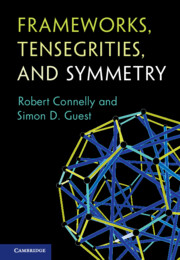Crossref Citations
This Book has been
cited by the following publications. This list is generated based on data provided by Crossref.
Nixon, Anthony
Schulze, Bernd
and
Whiteley, Walter
2021.
Rigidity through a Projective Lens.
Applied Sciences,
Vol. 11,
Issue. 24,
p.
11946.
Micheletti, Andrea
and
Podio-Guidugli, Paolo
2022.
Seventy years of tensegrities (and counting).
Archive of Applied Mechanics,
Vol. 92,
Issue. 9,
p.
2525.
Gandikota, M. C.
Parker, Amanda
and
Schwarz, J. M.
2022.
Rigidity transitions in zero-temperature polygons.
Physical Review E,
Vol. 106,
Issue. 5,
Xiao, Fan
Yang, Qingkai
Zhao, Xinyue
and
Fang, Hao
2022.
A Framework for Optimized Topology Design and Leader Selection in Affine Formation Control.
IEEE Robotics and Automation Letters,
Vol. 7,
Issue. 4,
p.
8627.
He, Zeyuan
and
Guest, Simon D.
2022.
On rigid origami III: local rigidity analysis.
Proceedings of the Royal Society A: Mathematical, Physical and Engineering Sciences,
Vol. 478,
Issue. 2258,
Jordán, Tibor
and
Tanigawa, Shin-ichi
2022.
Rigidity of Random Subgraphs and Eigenvalues of Stiffness Matrices.
SIAM Journal on Discrete Mathematics,
Vol. 36,
Issue. 3,
p.
2367.
WANG, Changhong
and
CHEN, Jize
2023.
A high-mobility formation control method based on the principle of projective invariance.
SCIENTIA SINICA Informationis,
Vol. 53,
Issue. 10,
p.
1965.
Alexandrov, V. A.
2023.
On the Existence of Two Affine-Equivalent Frameworks with Prescribed Edge Lengths in Euclidean $ d $-Space.
Siberian Mathematical Journal,
Vol. 64,
Issue. 6,
p.
1273.
Dosmagulova, Karlygash
Mityushev, Vladimir
and
Zhunussova, Zhanat
2023.
On the Optimal Conductivity of Packed Two-Dimensional Dispersed Composites.
SIAM Journal on Applied Mathematics,
Vol. 83,
Issue. 3,
p.
985.
Owen, J.
and
Schulze, B.
2024.
Mobility of geometric constraint systems with extrusion symmetry.
Beiträge zur Algebra und Geometrie / Contributions to Algebra and Geometry,
Rocks, Jason W.
and
Mehta, Pankaj
2024.
Integrating local energetics into Maxwell-Calladine constraint counting to design mechanical metamaterials.
Physical Review E,
Vol. 110,
Issue. 2,
Oba, Ryoshun
and
Tanigawa, Shin‐ichi
2024.
Super stable tensegrities and the Colin de Verdière number ν $\nu $.
Journal of Graph Theory,



